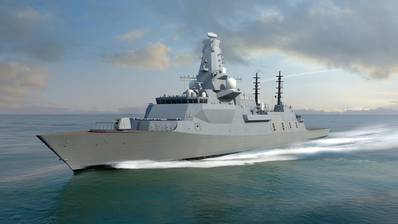Steel Cut for UK's New Warship HMS Belfast
A steel cutting ceremony was held for the U.K. Royal Navy's third Type 26 frigate, HMS Belfast, with all three of the first batch of City Class frigates now under construction.
Prince William, Duke of Cambridge, set the plasma cutting machine to work on the first plate of steel at BAE Systems’ shipyard in Glasgow. The U.K.-sourced steel plate will form part of a unit which will contain the machinery space for the gearbox and stabilizers of HMS Belfast.
Minister of State for Defense Baroness Goldie, said, "Today is a significant milestone for the exciting new Type 26 frigate program and for Defense. We celebrate and receive great support from our U.K. shipyards. As a Scot, I am very proud of the skills and expertise of our Scottish shipbuilders here on the Clyde.
"These new frigates will be equipped with the most advanced capabilities and technologies, enabling the Royal Navy to counter emerging global threats for decades to come."
Rear Admiral Paul Marshall, Director Navy Acquisition, said, "It’s been a privilege to witness this important moment in the life of our third Type 26 frigate and I'm delighted that His Royal Highness The Duke of Cambridge was able to come here today to cut the first steel for the future HMS Belfast.
"Despite the obstacles of the past year, BAE Systems’ workforce has continued to deliver what will be a world-leading maritime capability that will join an innovative and forward-looking Royal Navy. We are very proud to work closely with industry to realize the immense opportunity that these ships offer to our growing maritime ambition, our international partners and to the whole of the United Kingdom."
In recent weeks the first of class, HMS Glasgow, was rolled out of the build hall into the open for the first time, while progress on HMS Cardiff continues at pace, with more than 40% of the ship’s units in build at the Company’s Govan shipyard.
Defense Equipment and Support Director General Ships, Vice Admiral Christopher Gardner, said, "Standing in the shadow of HMS Glasgow which has been brought together on the hardstanding, with large parts of HMS Cardiff in construction around us, today’s steel cut for HMS Belfast is another significant milestone in the delivery of the eight-ship Type 26 class, itself part of the wider Global Combat Ship endeavor that we are part of along with Australia and Canada.
"This is a proud moment for everyone who has worked so hard on this strategic national program, which sustains thousands of jobs across the United Kingdom and harnesses all of our skills and knowledge to produce the best possible ships for the Royal Navy.”
"It’s a great honor to welcome the Duke of Cambridge to our facilities here in Glasgow to join our colleagues and guests on this very proud day. The world-class skills and expertise demonstrated by our teams and suppliers right across the U.K. play a critical role in delivering this vital advanced capability to the Royal Navy. The City Class frigates are at the pinnacle of complex warship capability and, together with our teams, I look forward to seeing the progress of all three ships," said Simon Lister, Managing Director of BAE Systems’ Naval Ships business
The Type 26 frigate is an advanced anti-submarine warship which will deliver critical protection of the Royal Navy’s Continuous At Sea Deterrent and Carrier Strike Group. Each Type 26 will be equipped with a range of world-class capabilities including the Sea Ceptor missile defense system, a 5-inch medium caliber gun, flexible mission bay, Artisan 997 Medium Range Radar and towed array sonar. The flight deck will be able to accommodate helicopters up to the size of a Chinook, while the mission bay can quickly adapt to house containers and deploy manned or unmanned vessels and vehicles.
Type 26 has been designed to reduce environmental impacts, with features including a hydrodynamically designed hull to optimize fuel efficiency and an advanced anti-fouling coating, which prevents marine growth and stops the transfer of invasive species on the hull. Each ship will also benefit from diesel engine emissions abatement, which reduces nitrogen oxide exhaust emissions and a waste water treatment system, which treats all ship effluent prior to discharge into the sea. Furthermore, it is envisaged that as new technologies become available, there will be potential opportunities for Type 26 to further mitigate its environmental impact.
Supporting more than 4,000 jobs across the U.K., the Type 26 program is making a significant contribution to the nation’s economic recovery by maintaining much-needed skills and capabilities. To date, more than £1 billion has been invested across the program’s supply chain, with more than 100 suppliers globally.
The Global Combat Ship supports a close partnership between the Royal Navy, Royal Canadian Navy and the Royal Australian Navy, supporting greater operational, training and intelligence ties. In total, the U.K., Australian and Canadian Navies will operate 32 anti-submarine warfare frigates, all based on the Type 26 reference design.












